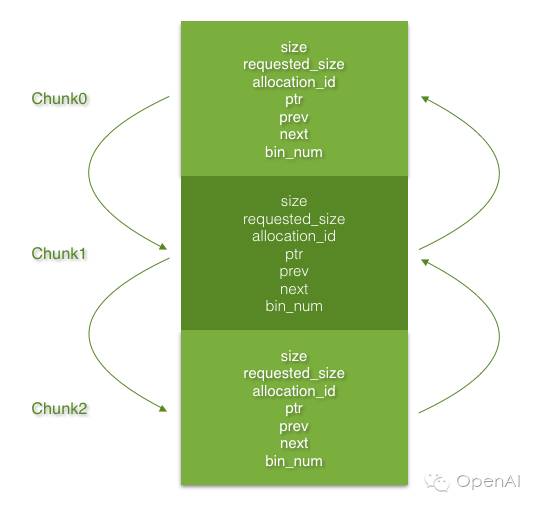TensorFlow内存管理bfc算法
来源:互联网 发布:mac 安装的程序在哪里 编辑:程序博客网 时间:2024/06/14 16:11
1. 基本介绍
- tensorflow设备内存管理模块实现了一个best-fit with coalescing算法(后文简称bfc算法)。
- bfc算法是Doung Lea’s malloc(dlmalloc)的一个非常简单的版本。
- 它具有内存分配、释放、碎片管理等基本功能。
2. bfc基本算法思想
1. 数据结构
整个内存空间由一个按基址升序排列的Chunk双向链表来表示,它们的直接前趋和后继必须在地址连续的内存空间。Chunk结构体里含有实际大小、请求大小、是否被占用、基址、直接前趋、直接后继、Bin索引等信息。

2. 申请
- 用户申请一个内存块(malloc)。根据chunk双链表找到一个合适的内存块,如果该内存块的大小是用户申请的大小的二倍以上,那么就将该内存块切分成两块,这就是split操作。
- 返回其中一块给用户,并将该内存块标识为占用
- Spilt操作会新增一个chunk,所以需要修改chunk双链表以维持前驱和后继关系
- 如果用户申请512的空间,正好有一块1024的chunk2是空闲的,由于1024/512 =2,所以chunk2 被split为2块:chunk2_1和chunk2_2。返回chunk2_1给用户并将其标志位占用状态。
3. 释放
- 用户释放一个内存块(free)。先将该块标记为空闲。然后根据chunk数据结构中的信息找到其前驱和后继内存块。如果前驱和后继块中有空闲的块,那么将刚释放的块和空闲的块合并成一个更大的chunk(这就是merge操作,合并当前块和其前后的空闲块)。再修改双链表结构以维持前驱后继关系。这就做到了内存碎片的回收。
- 如果用户要free chunk3,由于chunk3的前驱chunk2也是空闲的,所以将chunk2和chunk3合并得到一个新的chunk2’,大小为chunk2和chunk3之和。
3. bins
1. bins数据结构
- bfc算法采取的是被动分块的策略。最开始整个内存是一个chunk,随着用户申请空间的次数增加,最开始的大chunk会被不断的split开来,从而产生越来越多的小chunk。当chunk数量很大时,为了寻找一个合适的内存块而遍历双链表无疑是一笔巨大的开销。为了实现对空闲块的高效管理,bfc算法设计了bin这个抽象数据结构。
每个bin都有一个size属性,一个bin是一个拥有chunk size >= binsize的空闲chunk的集合。集合中的chunk按照chunk size的升序组织成单链表。bfc算法维护了一个bin的集合:bins。它由多个bin以及从属于每个bin的chunks组成。内存中所有的空闲chunk都由bins管理。
图中每一列表示一个bin,列首方格中的数字表示bin的size。bin size的大小都是256的2^n的倍。每个bin下面挂载了一系列的空闲chunk,每个chunk的chunk size都大于等于所属的bin的bin size,按照chunk size的升序挂载成单链表。
2. bins操作
- bfc算法针对bins这个集合设计了三个操作:search、insert、delete。
- search
给定一个chunk size,从bins中找到大于等于该chunksize的最小的那个空闲chunk。Search操作具体流程如下。如果bin以数组的形式组织,那么可以从index = chunk size /256 >>2的那个bin开始查找。最好的情况是开始查找的那个bin的chunk链表非空,那么直接返回链表头即可。这种情况时间复杂度是常数级的。最坏的情况是遍历bins数组中所有的bin。对于一般大小的内存来说,bins数组元素非常少,比如4G空间只需要23个bin就足够了(256 * 2 ^ 23 > 4G),因此也很快能返回结果。总体来说search操作是非常高效的。对于固定大小内存来说,查找时间是常数量级的。 - insert
将一个空闲的chunk插入到一个bin所挂载的chunk链表中,同时需要维持chunk链表的升序关系。具体流程是直接将chunk插入到index = chunk size /256 >>2的那个bin中即可。 - delete
将一个空闲的chunk从bins中移除。
- search
4. 总结
- 将内存分块管理,按块进行空间分配和释放。
- 通过split操作将大内存块分解成用户需要的小内存块。
- 通过merge操作合并小的内存块,做到内存碎片回收
- 通过bin这个抽象数据结构实现对空闲块高效管理。
5. 代码分析
1. 代码地址
- https://github.com/tensorflow/tensorflow/tree/master/tensorflow/core/common_runtime
2. 数据结构
- Chunk
static const int kInvalidChunkHandle = -1;...struct Chunk { size_t size = 0; // Full size of buffer. // We sometimes give chunks that are larger than needed to reduce // fragmentation. requested_size keeps track of what the client // actually wanted so we can understand whether our splitting // strategy is efficient. size_t requested_size = 0; // allocation_id is set to -1 when the chunk is not in use. It is assigned a // value greater than zero before the chunk is returned from // AllocateRaw, and this value is unique among values assigned by // the parent allocator. int64 allocation_id = -1; void* ptr = nullptr; // pointer to granted subbuffer. // If not kInvalidChunkHandle, the memory referred to by 'prev' is directly // preceding the memory used by this chunk. E.g., It should start // at 'ptr - prev->size' ChunkHandle prev = kInvalidChunkHandle; // If not kInvalidChunkHandle, the memory referred to by 'next' is directly // following the memory used by this chunk. E.g., It should be at // 'ptr + size' ChunkHandle next = kInvalidChunkHandle; // What bin are we in? BinNum bin_num = kInvalidBinNum; bool in_use() const { return allocation_id != -1; }};- Bin
// A Bin is a collection of similar-sized free chunks.struct Bin { // All chunks in this bin have >= bin_size memory. size_t bin_size = 0; struct ChunkComparator { explicit ChunkComparator(BFCAllocator* allocator) : allocator_(allocator) {} // Sort first by size and then use pointer address as a tie breaker. bool operator()(const ChunkHandle ha, const ChunkHandle hb) const NO_THREAD_SAFETY_ANALYSIS { const Chunk* a = allocator_->ChunkFromHandle(ha); const Chunk* b = allocator_->ChunkFromHandle(hb); if (a->size != b->size) { return a->size < b->size; } return a->ptr < b->ptr; } private: BFCAllocator* allocator_; // The parent allocator }; typedef std::set<ChunkHandle, ChunkComparator> FreeChunkSet; // List of free chunks within the bin, sorted by chunk size. // Chunk * not owned. FreeChunkSet free_chunks; Bin(BFCAllocator* allocator, size_t bs) : bin_size(bs), free_chunks(ChunkComparator(allocator)) {}};- AllocationRegion
- AllocationRegion给一个连续的内存区域做指针到ChunkHandle的映射。
- RegionManager
- RegionManager聚集了一个或多个AllocationRegion,并提供一个从指针到基础ChunkHandle的间接层,这个间接层可在多个不连续的内存区域进行分配。
3. 分配大小
- 将每次分配的内存大小调整为kMinAllocationSize的N倍,这样所有内存地址都是很好地按字节对齐了。
// kMinAllocationSize = 256static const size_t kMinAllocationBits = 8;static const size_t kMinAllocationSize = 1 << kMinAllocationBits;...size_t BFCAllocator::RoundedBytes(size_t bytes) { size_t rounded_bytes = (kMinAllocationSize * ((bytes + kMinAllocationSize - 1) / kMinAllocationSize)); DCHECK_EQ(size_t{0}, rounded_bytes % kMinAllocationSize); return rounded_bytes;}4. 初始化bin
typedef int BinNum;static const int kInvalidBinNum = -1;static const int kNumBins = 21;...// 二进制2^8往左移0,1,2位// (static_cast<size_t>(256) << 0) = 256// (static_cast<size_t>(256) << 1) = 512// (static_cast<size_t>(256) << 2) = 1024size_t BinNumToSize(BinNum index) { return static_cast<size_t>(256) << index;}...char bins_space_[sizeof(Bin) * kNumBins];// Map from bin size to BinBin* BinFromIndex(BinNum index) { return reinterpret_cast<Bin*>(&(bins_space_[index * sizeof(Bin)]));}...// We create bins to fit all possible ranges that cover the// memory_limit_ starting from allocations up to 256 bytes to// allocations up to (and including) the memory limit.for (BinNum b = 0; b < kNumBins; b++) { size_t bin_size = BinNumToSize(b); VLOG(1) << "Creating bin of max chunk size " << strings::HumanReadableNumBytes(bin_size); new (BinFromIndex(b)) Bin(this, bin_size); CHECK_EQ(BinForSize(bin_size), BinFromIndex(b)); CHECK_EQ(BinForSize(bin_size + 255), BinFromIndex(b)); CHECK_EQ(BinForSize(bin_size * 2 - 1), BinFromIndex(b)); if (b + 1 < kNumBins) { CHECK_NE(BinForSize(bin_size * 2), BinFromIndex(b)); }}5. 查找bin
// 求属于第几个binBinNum BinNumForSize(size_t bytes) { uint64 v = std::max<size_t>(bytes, 256) >> kMinAllocationBits; int b = std::min(kNumBins - 1, Log2FloorNonZero(v)); return b;}// 最高位非零的二进制位数,eg: 0001 0101B 为5inline int Log2FloorNonZero(uint64 n) {#if defined(__GNUC__) return 63 ^ __builtin_clzll(n);#elif defined(PLATFORM_WINDOWS) unsigned long index; _BitScanReverse64(&index, n); return index;#else int r = 0; while (n > 0) { r++; n >>= 1; } return r;#endif}6. 查找Chunk
// 先加锁mutex_lock l(lock_);void* ptr = FindChunkPtr(bin_num, rounded_bytes, num_bytes);if (ptr != nullptr) { return ptr;}// FindChunkPtr函数内部void* BFCAllocator::FindChunkPtr(BinNum bin_num, size_t rounded_bytes, size_t num_bytes) { // First identify the first bin that could satisfy rounded_bytes. for (; bin_num < kNumBins; bin_num++) { // Start searching from the first bin for the smallest chunk that fits // rounded_bytes. Bin* b = BinFromIndex(bin_num); for (auto citer = b->free_chunks.begin(); citer != b->free_chunks.end(); ++citer) { // 从之前得到的Bin索引开始,查找合适的空闲Chunk: const BFCAllocator::ChunkHandle h = (*citer); BFCAllocator::Chunk* chunk = ChunkFromHandle(h); DCHECK(!chunk->in_use()); if (chunk->size >= rounded_bytes) { // We found an existing chunk that fits us that wasn't in use, so remove // it from the free bin structure prior to using. RemoveFreeChunkIterFromBin(&b->free_chunks, citer); // If we can break the size of the chunk into two reasonably // large pieces, do so. // // TODO(vrv): What should be the criteria when deciding when // to split? // 具体实现后面会分析 if (chunk->size >= rounded_bytes * 2) { SplitChunk(h, rounded_bytes); chunk = ChunkFromHandle(h); // Update chunk pointer in case it moved } // The requested size of the returned chunk is what the user // has allocated. chunk->requested_size = num_bytes; // Assign a unique id and increment the id counter, marking the // chunk as being in use. chunk->allocation_id = next_allocation_id_++; // Update stats. ++stats_.num_allocs; stats_.bytes_in_use += chunk->size; stats_.max_bytes_in_use = std::max(stats_.max_bytes_in_use, stats_.bytes_in_use); stats_.max_alloc_size = std::max<std::size_t>(stats_.max_alloc_size, chunk->size); VLOG(4) << "Returning: " << chunk->ptr; if (VLOG_IS_ON(4)) { LOG(INFO) << "A: " << RenderOccupancy(); } return chunk->ptr; } } } return nullptr;}7. 拆分Chunk
- 如果Chunk的大小大于等于申请内存大小的2倍,那么将该Chunk拆分成2个:第一个Chunk的大小等于申请内存大小,第二个Chunk作为它的直接后继。
if (chunk->size >= rounded_bytes * 2) { SplitChunk(h, rounded_bytes); chunk = ChunkFromHandle(h); // Update chunk pointer in case it moved}void BFCAllocator::SplitChunk(BFCAllocator::ChunkHandle h, size_t num_bytes) { // Allocate the new chunk before we do any ChunkFromHandle ChunkHandle h_new_chunk = AllocateChunk(); Chunk* c = ChunkFromHandle(h); CHECK(!c->in_use() && (c->bin_num == kInvalidBinNum)); // Create a new chunk starting num_bytes after c BFCAllocator::Chunk* new_chunk = ChunkFromHandle(h_new_chunk); new_chunk->ptr = static_cast<void*>(static_cast<char*>(c->ptr) + num_bytes); region_manager_.set_handle(new_chunk->ptr, h_new_chunk); // Set the new sizes of the chunks. new_chunk->size = c->size - num_bytes; c->size = num_bytes; // The new chunk is not in use. new_chunk->allocation_id = -1; // Maintain the pointers. // c <-> c_neighbor becomes // c <-> new_chunk <-> c_neighbor BFCAllocator::ChunkHandle h_neighbor = c->next; new_chunk->prev = h; new_chunk->next = h_neighbor; c->next = h_new_chunk; if (h_neighbor != kInvalidChunkHandle) { Chunk* c_neighbor = ChunkFromHandle(h_neighbor); c_neighbor->prev = h_new_chunk; } // Add the newly free chunk to the free bin. InsertFreeChunkIntoBin(h_new_chunk);}8. 回收chunk
- 加锁,获得ChunkHandle
mutex_lock l(lock_);BFCAllocator::ChunkHandle h = region_manager_.get_handle(ptr);FreeAndMaybeCoalesce(h);- FreeAndMaybeCoalesce
void BFCAllocator::FreeAndMaybeCoalesce(BFCAllocator::ChunkHandle h) { Chunk* c = ChunkFromHandle(h); CHECK(c->in_use() && (c->bin_num == kInvalidBinNum)); // Mark the chunk as no longer in use c->allocation_id = -1; // Updates the stats. stats_.bytes_in_use -= c->size; // This chunk is no longer in-use, consider coalescing the chunk // with adjacent chunks. ChunkHandle chunk_to_reassign = h; // If the next chunk is free, coalesce the two if (c->next != kInvalidChunkHandle) { Chunk* cnext = ChunkFromHandle(c->next); if (!cnext->in_use()) { // VLOG(8) << "Chunk at " << cnext->ptr << " merging with c " << // c->ptr; chunk_to_reassign = h; // Deletes c->next RemoveFreeChunkFromBin(c->next); Merge(h, ChunkFromHandle(h)->next); } } // If the previous chunk is free, coalesce the two c = ChunkFromHandle(h); if (c->prev != kInvalidChunkHandle) { Chunk* cprev = ChunkFromHandle(c->prev); if (!cprev->in_use()) { // VLOG(8) << "Chunk at " << c->ptr << " merging into c->prev " // << cprev->ptr; chunk_to_reassign = c->prev; // Deletes c RemoveFreeChunkFromBin(c->prev); Merge(ChunkFromHandle(h)->prev, h); c = ChunkFromHandle(h); } } InsertFreeChunkIntoBin(chunk_to_reassign);}- Merge
// Merges h1 and h2 when Chunk(h1)->next is h2 and Chunk(h2)->prev is c1.// We merge Chunk(h2) into Chunk(h1).void BFCAllocator::Merge(BFCAllocator::ChunkHandle h1, BFCAllocator::ChunkHandle h2) { Chunk* c1 = ChunkFromHandle(h1); Chunk* c2 = ChunkFromHandle(h2); // We can only merge chunks that are not in use. CHECK(!c1->in_use() && !c2->in_use()); // c1's prev doesn't change, still points to the same ptr, and is // still not in use. // Fix up neighbor pointers // // c1 <-> c2 <-> c3 should become // c1 <-> c3 BFCAllocator::ChunkHandle h3 = c2->next; c1->next = h3; CHECK(c2->prev == h1); if (h3 != kInvalidChunkHandle) { BFCAllocator::Chunk* c3 = ChunkFromHandle(h3); c3->prev = h1; } // Set the new size c1->size += c2->size; DeleteChunk(h2);}6. 参考
- https://github.com/tensorflow/tensorflow
- http://www.cnblogs.com/yao62995/p/5773166.html
- https://deepreve.github.io/articles/20161007.html
阅读全文
0 0
- TensorFlow内存管理bfc算法
- tensorflow设备内存分配算法解析 (BFC算法)
- TensorFlow 源码分析之内存管理BFC算法—DeepReve
- 内存管理算法介绍
- 内存管理算法
- 内存管理算法实现
- 内存管理算法--伙伴算法
- BFC
- BFC
- BFC
- BFC
- BFC
- BFC
- BFC
- BFC
- BFC
- BFC
- BFC
- iOS MVVM+RAC 从框架到实战
- Maven+Spring+Mybatis+SpringMvc所需要导入的jar包坐标
- tensorflow实现简单的矩阵相乘
- 嵌入式系统开发之驱动篇001——LED驱动
- Linux之多线程及互斥锁pthread_mutex_t的学习
- TensorFlow内存管理bfc算法
- 学编程,你不能学会了游泳再下水
- vue中的报错情况
- 解决POI读取Excel内存溢出的问题
- SQL/PLSQL:行转列总结_20170822
- Spring AOP详解
- MATLAB 牛顿迭代法解非线性方程组
- ubuntu16.04耳机没声音解决
- PAT-A 1006. Sign In and Sign Out (25)



